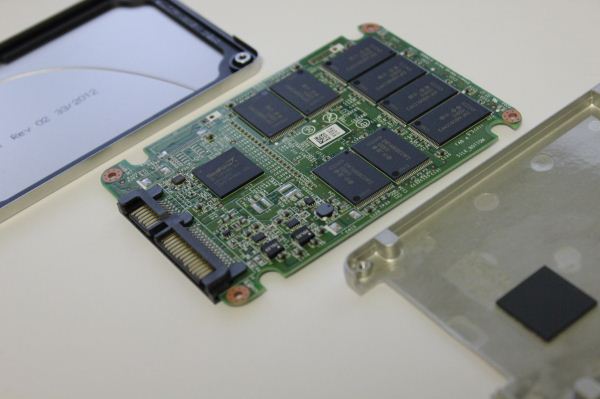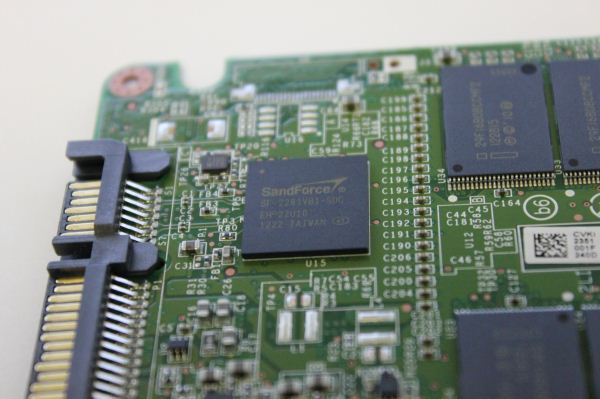Intel SSD 335 (240GB) Review
by Kristian Vättö on October 29, 2012 11:30 AM ESTInside the Intel SSD 335
Similar to the SSD 330, the SSD 335 has a single thermal pad covering the controller. The whole case is made out of metal, so heat dissipation in general should not be an issue. There doesn't seem to be any visible differences between the PCBs of SSD 335 and 330, other than the fact that the SSD 335 loses the "BIN 2" sticker and is manufactured in fab 4 instead of fab 3 (although it's completely possible that SSD 335s are manufactured in fab 3 as well).
The SF-2281
As usual, there are a total of sixteen NAND packages, eight on each side of the PCB. Each NAND package consists of two 8GB 20nm MLC NAND dies, making each NAND package 16GB in capacity. The new 20nm process node is indicated by the 12th character, which is an F. Process nodes follow the alphabet, meaning that F is 20nm, E is 25nm, D is 34nm and so on.
Test System
| CPU |
Intel Core i5-2500K running at 3.3GHz (Turbo and EIST enabled) |
| Motherboard |
AsRock Z68 Pro3 |
| Chipset |
Intel Z68 |
| Chipset Drivers |
Intel 9.1.1.1015 + Intel RST 10.2 |
| Memory | G.Skill RipjawsX DDR3-1600 2 x 4GB (9-9-9-24) |
| Video Card |
XFX AMD Radeon HD 6850 XXX (800MHz core clock; 4.2GHz GDDR5 effective) |
| Video Drivers | AMD Catalyst 10.1 |
| Desktop Resolution | 1920 x 1080 |
| OS | Windows 7 x64 |













69 Comments
View All Comments
meloz - Tuesday, October 30, 2012 - link
>After Anandtech's 840 Pro review sample died, I'm not super inspired with confidence about the plain 840.Oops, I had almost forgotten about that, thanks for the reminder.
Damn, all SSD manufacturers suck in their own ways.
jwilliams4200 - Thursday, November 1, 2012 - link
I'm disappointed that there hasn't been any more information on that 840 Pro that died.Anand should really post some more details. Like what it was doing just before it died, the symptoms of how it failed, whether the SMART parameters could still be read, etc.
Also, Anand should be hounding Samsung to get back to him about it, if they haven't already. The 840 Pro is apparently shipping on Nov 6. If Samsung has not been able to diagnose the problem and report back by then, it looks bad for Samsung.
Kristian Vättö - Thursday, November 1, 2012 - link
Anand was filling the drive with sequential data (preconditioning it for our enterprise tests) and it just died in the middle of the run. After that it was no longer recognized in BIOS, not even when connected using USB to SATA adapter.As far as I know, Samsung has not gotten back to us about it yet but let me ask Anand and see if he knows more.
jwilliams4200 - Thursday, November 1, 2012 - link
Thank you for the additional information.I am highly interested in what Samsung has to say about the failure. It seems to me that anandtech should be able to put some pressure on Samsung to give them a thorough failure analysis in a timely manner, or else anandtech will report that Samsung was unable to explain the failure and that looks bad for Samsung.
mmonnin03 - Tuesday, October 30, 2012 - link
The flash on SSDs arent going to get more reliable. ECC basically scales exponentially as the process dimensions keep shrinking. As the lines get closer and closer, the number of electrons holding the charge becomes harder and harder to measure. Each cell is 2 bits, so 4 different amounts of electrons need to be measured. Errors occur more frequently and get fixed. And that's not going to make the NAND any faster by going smaller. SSD speed/reliability improvements will/have come at the controller level. If you truly want a reliable SSD, go 34nm SLC. Its still being produced.jeffrey - Monday, October 29, 2012 - link
Between the Samsung 840 Pro dying during testing and now the endurance issue testing Intel's 335, I believe OCZ should get some more credit for their Vertex 4.Everyone wants to mention Intel, Micron/Crucial, and Samsung for SSDs, but the Vertex 4 deserves to be there too.
josephjpeters - Monday, October 29, 2012 - link
Endurance will play a larger role in differentiating future SSD's as the industry continues to move to smaller NAND geometries.I'm interested in seeing OCZ's Vector which will use 20nm MLC NAND. It'll be a big test for OCZ to see how their endurance technology stacks up against the competition (or lack thereof in the consumer space).
Samus - Monday, October 29, 2012 - link
I've had my Intel SSD320 160GB for about two years, use it daily, and still have only written 10.6TB to it and the MWI is still 100%.Either way you look at it, this drive will last the average user a decade easily, even with less than 1000 P/E
IntelUser2000 - Tuesday, October 30, 2012 - link
This is false: "Based on the data I gathered, the MWI would hit 0 after around 250TB of NAND writes, which translates to less than 1,000 P/E cycles."There is a forum that exclusively tests SSD endurance and Intel drives last far past the MWI of 0. In fact, after it reached zero, it started counting up. I remember the original X25-M lasting until the second MWI is significantly greater than 25(it could be 50 I don't remember).
They thought that after the Media Wearout Indicator reached 0, the drive would die. In fact, none of the drives did. NONE.
Even 240TB is hell of a lot. My X25-M has 7.6TB written to it and I had it since the year the drive was announced. At this rate, I'll be 30 years older by the time it reaches that point. So its a needless worry about nothing.
Contrary to Platter HDDs, which die off slowly and more and more data gets corrupted and gets slower and slower until you notice that the drive is dying. Less than 5 years for lot of people around me too.
Kristian Vättö - Tuesday, October 30, 2012 - link
I did not say the drive will die after the MWI hits 1. In fact, I said the opposite:"Even after it has hit 1, it's likely the drive can still withstand additional write/erase cycles thanks to MLC NAND typically behaving better than the worst-case estimates."
The problem here isn't that 1,000 P/E cycles isn't enough for a consumer, but the fact that there seems to be a huge difference in endurance between 20nm MLC and 25nm MLC if our data is correct. Intel claimed that there is no difference, both are 3,000 P/E cycles, but our data contradicts with theirs. Given that the SSD 335 doesn't bring any immediate price cuts, you are getting a worse product for the same money compared to the SSD 330.
It's of course possible that there is a simple firmware bug which reports wrong MWI or NAND writes, but at least so far Intel has not said anything to suggest that.